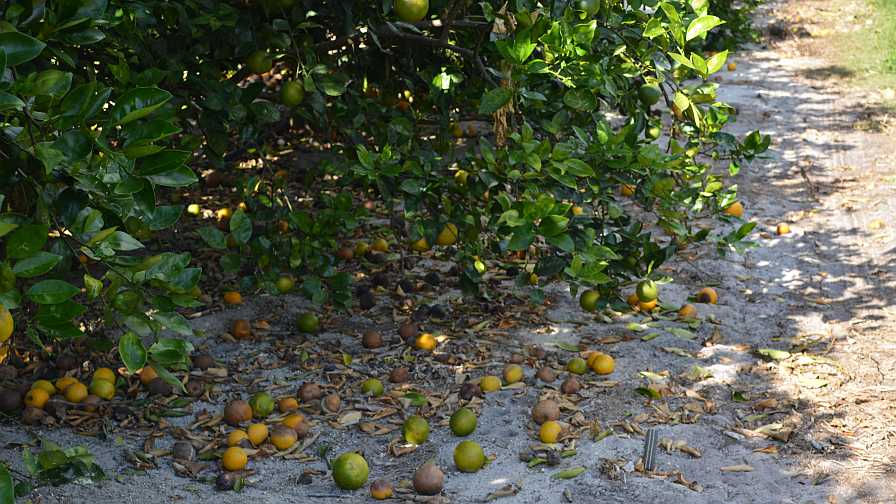
While evaluating new citrus varieties, make sure to report unusual fruit drop to plant breeders. Photo by Frank Giles
Florida citrus nurseries and growers have been quick to adopt new varieties for trial and commercial production on a range of scales. Because many of these citrus varieties are made available with limited or no data, production plans are being developed on the fly. This certainly isn’t ideal; it’s just a reflection of our current situation.
Florida needs varieties with more favorable characteristics (timing of maturity, fruit quality, juice quality, production, and HLB-tolerance) but can’t wait for 15 years of field and greenhouse trials to identify the sure winners and losers. However, early adoption certainly has its pros and cons. Not all of these new varieties will work, but the ones that do will be the foundation of our future.
While Florida citrus nurseries are working out propagation and greenhouse production plans, growers are doing the same in the field. Simultaneously, most of the promising selections are being included in the new large-scale structured field trials in order to generate data that may support more wide-scale adoption. Florida now sits in the middle of these two ongoing efforts. Though this may be a somewhat frustrating situation, there is much to be accomplished in this space.
Observe and Report
It is vital that observations, successes, and challenges be communicated to the breeding teams so they can be recorded in real time. Here are some suggestions:
- Growers need to spend some time in their trial blocks. Report unusual growth patterns, or nutritional issues. Also, share information about overall tree health, fruit set, fruit quality, etc. I often ask growers how variety “X” is doing, and they reply: “I don’t know, but I’ll go look.” Assign someone the responsibility of driving or walking these rows on a regular basis. You don’t want to miss something important. Take photos when possible.
- Florida Citrus Nurseries may notice nutritional deficiencies or other growth issues. While resolving these issues internally may represent a short-term proprietary advantage, sharing this information will help accelerate the industry up the learning curve and increase grower and nursery confidence. This goes for growers, too. A healthy industry supports everyone. Share what you are learning. Share what works and what doesn’t. Sometimes knowing what hole not to step in can be just as valuable as having the ultimate answer.
- Report issues with bloom or lack thereof. The same applies to the fruit set. The issues may be widespread or isolated. Unless this is reported as it is happening, it will take another year to figure it out.
- Report uncommonly high fruit drop. Sometimes this is caused by HLB, sometimes its weather, but other times it may be something controllable or represent a susceptibility that the industry needs to know about. Again, if not reported while it is happening, we lose an entire year in developing an explanation or solution.
- Report apparent root issues. Many of these new scions are being propagated onto newly available rootstocks and much can be learned from observations of the various combinations. If you see trees on one rootstock behaving different than another, let the breeders know. This might be valuable information. They will engage others within their team to determine whether it’s an isolated incident or one that warrants further study.
- Report issues with dieback or unusual tree loss. If your reset percentage seems out of whack, reach out. Too often we hear of a grower walking away from a variety out of frustration, but the issues were never reported. They may not have been resolvable, but then again, they might have been.
- Growers producing for the fresh market are encouraged to either contact the breeding team that developed the variety to offer fruit for postharvest analysis or to run some fruit through a packing line and into storage for a self-study. Share your observations. If fruit won’t color — let the breeders know.
More Information Is Better
The UF/IFAS and USDA breeding teams, horticulturists, nutritionists, and pathologists certainly can’t visit every trial site. They are incredibly busy people, but like most people, they are more effective with more information. If your observations are common and fit a pattern that they are already seeing, a field visit may not make sense, but getting them focused on an important issue early can save the industry valuable time in its journey up the learning curve.
New Year Variety Displays
There are two more UF/IFAS Variety Display Opportunities on the calendar in 2020. Plan to attend and see the latest UF/IFAS citrus variety innovations.
- January 16 – Indian River County Fairgrounds, Vero Beach, 10 a.m.
- February 14 – Citrus Research and Education Center, Lake Alfred, 10 a.m.









